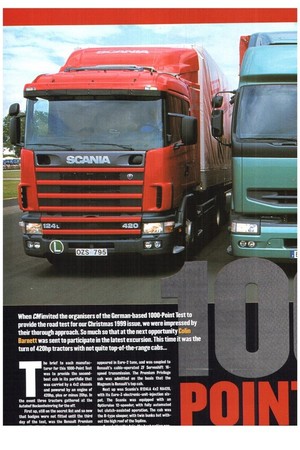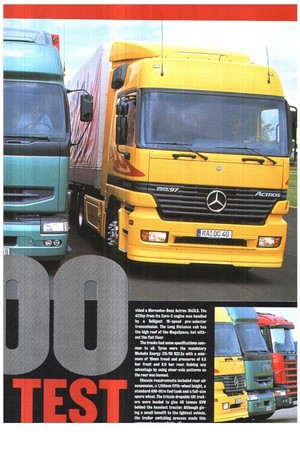When CMinvited the organisers of the German-based 1000-Point Test to
Page 30

Page 31

If you've noticed an error in this article please click here to report it so we can fix it.
provide the road test for our Christmas 1999 issue, we were impressed by their thorough approach. So much so that at the next opportunity Colin Barnett was sent to participate in the latest excursion. This time it was the turn of 420hp tractors with not quite top-of-the-range cabs...
The brief to each manufacturer for this 1000-Point Test was to provide the secondbest cab in its portfolio that was carried by a 4x2 chassis and powered by an engine of 420hp, plus or minus 20hp. In the event three tractors gathered at the Autohof Hockenheimring for the off.
First up, still on the secret list and so new that badges were not fitted until the third day of the test, was the Renault Premium appeared in Euro-2 tune, and was coupled to Renault's cable-operated 2F Servoshift 16speed transmission, The Premium Privilege cab was admitted on the basis that the Magnum is Renault's top cab.
Next up was Scania's R1241A 4x2 NA420, with its Euro-3 electronic-unit-injection sixpot. The Scania was equipped with an Opticruise 12-speeder, with fully automated but clutch-assisted operation. The cab was the R-type sleeper, with twin bunks but without the high roof of the Topline. vided a Mercedes-Benz Actros 1843LS. The 422hp from its Euro-2 engine was handled by a Telligent 16-speed pre-selector transmission. The Long Distance cab has the high roof of the MegaSpace, but without the flat floor.
The trucks had some specifications common to all. Tyres were the mandatory Michelin Energy 315/80 R22.5s with a minimum of 10mm tread and pressures of 8.5 bar front and 8,0 bar rear. Gaining any advantage by using steer-axle patterns on the rear was banned.
Chassis requirements included rear air suspension, a 1,150mm fifth-wheel height, a standard 400-litre fuel tank and a full-size spare wheel. The triaxle dropside tilt trailers were loaded to give 40 tonnes GVW behind the heaviest tractor. Although giving a small benefit to the lightest vehicle, the trailer switching process made this




















































































































